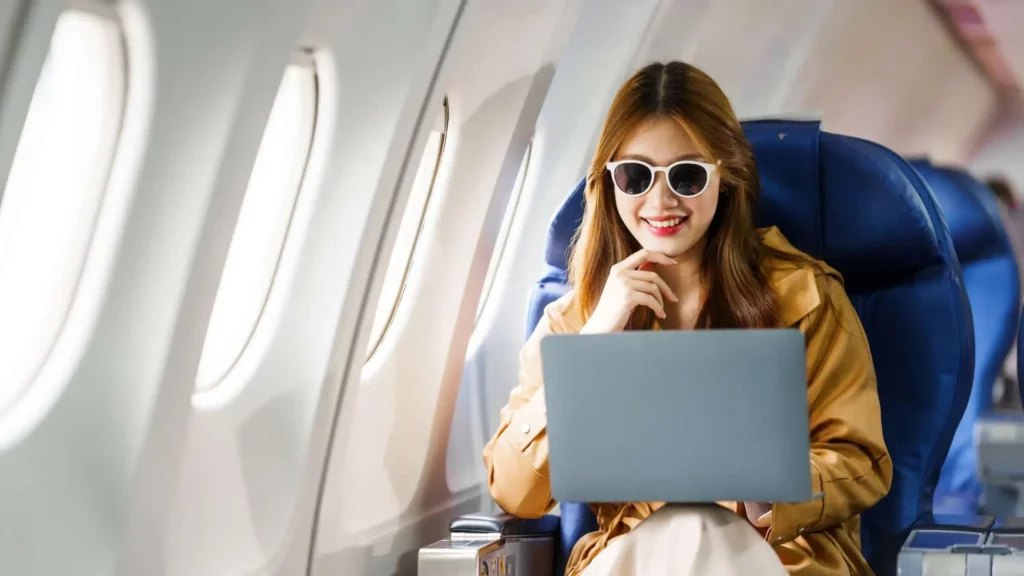Table of Contents
There’s something alluring about red-eye flights. They promise efficiency: board late at night, sleep through the journey, and wake up in a new city ready to explore. They’re often cheaper than daytime options, which appeals to budget-conscious travelers, and they save valuable daylight hours for sightseeing or work. For many, red-eyes feel like a travel hack — squeezing maximum time and value out of a trip.
But let’s be honest: the reality rarely matches the promise. Sleeping on a plane is hard. Cramped seats, noisy neighbors, fluctuating cabin temperatures, and constant interruptions mean many passengers step off groggy, dehydrated, and out of sync. Instead of hitting the ground running, they spend their first day recovering.
So, how do you make a red-eye flight work for you? The key is strategy. With the right preparation, smart in-flight tactics, and recovery planning, you can transform red-eye flights from an exhausting gamble into an efficient and even enjoyable part of your travel experience. This guide will walk you through everything: why red-eye flights are both popular and tricky, how to prepare your body and mind before departure, how to maximize rest in the air, and how to recover quickly after landing. You’ll also learn how Beem’s Budget Planner can help you allocate funds toward comfort upgrades, travel essentials, and wellness items that make the difference between survival and success.
By the end, you’ll have a complete red-eye flight survival plan — one that saves money, time, and energy while ensuring you arrive refreshed.
Why Red-Eye Flights Are Popular (But Tricky)
Budget-Friendly Pricing
One of the biggest draws of red-eye flights is cost. Airlines often price them lower than peak daytime flights because they’re less desirable for the average traveler. For budget-conscious adventurers, students, and families, these savings can be substantial. A $150 discount on airfare can mean more money for meals, tours, or even a hotel upgrade.
Yet cheaper fares sometimes come at a hidden cost: your comfort and well-being. Without a plan, the money saved on airfare can end up spent on recovery — whether it’s an extra night of accommodation to catch up on sleep or splurging on coffee just to stay awake the next day.
Time Efficiency
For business travelers and short vacationers, time is money. Red-eye flights maximize productivity by freeing up daytime hours. You leave at night, sleep (or at least attempt to), and arrive in the morning, ready to start meetings or sightseeing. For travelers with tight schedules, this efficiency makes red-eyes hard to resist.
The Downside: Sleep Disruption
The flip side is obvious: your sleep schedule pays the price. Most people struggle to sleep well sitting upright in a noisy, crowded cabin. Sleep deprivation reduces focus, mood, and energy, leaving you in worse shape than if you’d just flown during the day. Jet lag compounds the problem if you’re crossing multiple time zones, making recovery even harder.
The popularity of red-eyes lies in their promise, but their challenge lies in execution. That’s why a survival plan is crucial.
Preparing for a Red-Eye Flight

Adjust Your Sleep Schedule in Advance
One of the most effective strategies is to shift your sleep schedule gradually in the days leading up to your flight. If your red-eye departs at 11 p.m., try going to bed an hour later each night for several days prior. By the time you board, your body is already primed to rest at that hour. Even a small shift can help you fall asleep faster onboard.
Eat Smart Before Boarding
What you eat before a red-eye makes a huge difference. Heavy meals or caffeine close to departure can disrupt digestion and keep you awake. Instead, opt for a balanced, lighter meal with lean protein and complex carbs — something that satisfies hunger without weighing you down. Hydrating beverages like water or herbal tea are better choices than sodas or coffee.
Pack Sleep Essentials
Your carry-on is your survival kit. Essentials like a supportive neck pillow, eye mask, earplugs, and a light blanket or scarf create a more restful environment. Noise-canceling headphones are a worthy investment for frequent travelers. These small items can transform an uncomfortable cabin into a personal sleep zone.
Budgeting for Comfort
Sometimes spending a little extra upfront pays big dividends later. Seat upgrades for more legroom, airport lounge passes for a pre-flight nap, or even premium travel accessories can make or break your red-eye experience. With Beem’s Budget Planner, you can allocate funds ahead of time for these extras. Instead of splurging impulsively, you’ll know exactly how much you can afford to spend on comfort, ensuring your upgrades don’t derail your overall travel budget.
Read: How To Save Money For A Vacation In 6 Months
Sleeping Better on the Plane
Choose the Right Seat
Not all seats are created equal. Window seats are ideal for red-eyes since you can lean against the wall and aren’t disturbed by others needing the aisle. Bulkhead or exit-row seats provide extra legroom, though sometimes at a higher cost. Avoid seats near bathrooms or galleys, where noise and foot traffic are constant. If possible, check seat maps online before choosing your spot.
Create a Restful Environment
Airplanes aren’t designed for sleep, but you can hack your environment. Dim the cabin light on your side with an eye mask, reduce ambient noise with earplugs or headphones, and set your phone to “do not disturb.” Layer your clothing so you can adjust easily to fluctuating cabin temperatures. Small tweaks make a big difference in signaling to your body that it’s time to rest.
Use Relaxation Techniques
Falling asleep in an upright seat requires relaxation. Breathing exercises, meditation apps, or calming music playlists can quiet your mind. Even visualization techniques — imagining yourself at home in bed — can help trick your body into sleep. For some, melatonin or natural sleep aids can assist, but always test them at home before using them mid-flight.
Stay Hydrated (But Strategic)
Cabin air is notoriously dry, leading to dehydration that worsens fatigue. Drink water regularly throughout the flight, but don’t overdo it to the point of constant bathroom trips. Aim for a balance: enough hydration to feel good, but not so much that it disrupts your sleep cycle.
Post-Flight Recovery Strategies
Move and Stretch Immediately After Landing
Long hours of sitting stiffen muscles and reduce circulation. As soon as you disembark, stretch, walk, and move. Simple exercises — like shoulder rolls, calf raises, and light walking — help reenergize your body and reduce post-flight sluggishness.
Get Exposure to Natural Light
Your circadian rhythm depends on light cues. One of the fastest ways to reset your body clock is to step outside and soak up natural sunlight after landing. This tells your brain it’s daytime and helps reduce jet lag. If your destination is cloudy, bright indoor light can still help.
Time Your Naps Wisely
The temptation to crash immediately after landing is strong, but long naps can disrupt your adjustment to the local time zone. If you need to rest, keep it short — 20 to 30 minutes max. Then, push through to the local bedtime. This discipline speeds up recovery and ensures you sleep better at night.
Fuel Your Body with the Right Foods
Food is fuel, and after a red-eye, your body needs replenishment. Hydrating fruits, proteins, and complex carbs restore energy. Avoid heavy, greasy meals that can slow you down. A balanced breakfast or light meal after landing helps your body feel grounded and energized.
Read related blog: How To Save Money On Flights
Beating Jet Lag After a Red-Eye
Understand Your Destination’s Time Zone
Before landing, reset your watch or phone to local time. Mentally aligning with your new schedule helps reduce disorientation. Avoid thinking “it’s really 3 a.m. back home” — commit to the local time zone as quickly as possible.
Follow Local Schedules Quickly
Once you land, try to eat, sleep, and move according to local time. This means having meals when locals do and waiting until nighttime to sleep, even if you’re exhausted. It’s tough at first, but it significantly shortens jet lag.
Use Melatonin or Natural Sleep Aids Carefully
Supplements like melatonin can help regulate sleep cycles during the first few nights after arrival. Used correctly, they gently nudge your body toward adjusting. However, they should be used sparingly and tested before travel to ensure you respond well.
Real-Life Examples of Red-Eye Success
- Business Traveler Efficiency: Jason, a consultant, once dreaded red-eyes because they ruined his productivity. By shifting his sleep schedule before travel and budgeting for an aisle seat with extra legroom, he arrived rested and performed better at client meetings.
- Student Budget Hack: Maria, a college student flying to Europe, used Beem’s Budget Planner to save $50 a month toward an exit-row seat upgrade. It turned her red-eye into a tolerable experience, and she hit the ground ready for her study abroad program.
- Couple’s Recovery Plan: Alex and Priya, frequent leisure travelers, created a post-red-eye ritual: stretching after landing, having a healthy breakfast, and taking a short nap. Their consistent recovery plan meant they wasted less time on their first day abroad.
FAQs on Red-Eye Flight Survival
1. Are red-eye flights always cheaper?
Not always, but often. Airlines price them lower to fill less desirable overnight slots. However, during peak travel seasons or on high-demand routes, red-eyes may still be pricey. Comparing across dates and using fare trackers ensures you get the best deal.
2. What’s the best seat for sleeping on a plane?
Window seats are generally the best for rest since you can lean against the wall and avoid aisle disturbances. For extra comfort, bulkhead or exit-row seats provide more legroom, but they may cost extra.
3. Is it better to eat before or during a red-eye flight?
It depends on your body, but many travelers benefit from eating a light meal before boarding to avoid disrupted digestion in the air. Once onboard, keep food light and avoid caffeine or alcohol to maximize rest.
4. How long does it take to recover from jet lag?
Jet lag varies depending on time zones crossed and personal resilience. On average, it takes one day per time zone to fully adjust, though smart strategies — like light exposure and meal timing — can speed up recovery.
5. How does Beem help with planning red-eye comfort costs?
Beem’s Budget Planner lets you set aside funds for travel extras like seat upgrades, sleep gear, or lounge passes. By budgeting in advance, you can afford the small comforts that make red-eyes tolerable, without throwing off your overall trip spending.
Conclusion
Red-eye flights don’t have to feel like endurance tests. With the right preparation — adjusting your sleep schedule, packing strategically, and budgeting for comfort — they can become one of the smartest ways to save both time and money. Thoughtful choices like selecting the right seat, bringing noise-canceling headphones, and setting up a sleep-friendly routine can make even the longest overnight flight surprisingly restful.
The secret lies in balance: pairing cost savings with comfort. By using Beem’s Budget Planner, you can pre-plan for in-flight essentials like travel pillows, hydration kits, or lounge access, ensuring your red-eye experience is both affordable and comfortable. And if unexpected costs arise during your trip, Beem Everdraft™ gives you instant access to up to $1,000 — with no credit checks or interest — so you can handle travel surprises stress-free.
Beyond budgeting, Beem’s Smart Wallet and Cashflow AI help you manage trip expenses seamlessly, while Job Loss Protect™ offers financial security even when life takes unexpected turns. Together, these tools ensure your travel remains smooth, flexible, and financially sound from takeoff to touchdown.
Turn red-eyes into real wins — download the Beem app today to plan smarter, travel lighter, and wake up ready to explore wherever you land.














































